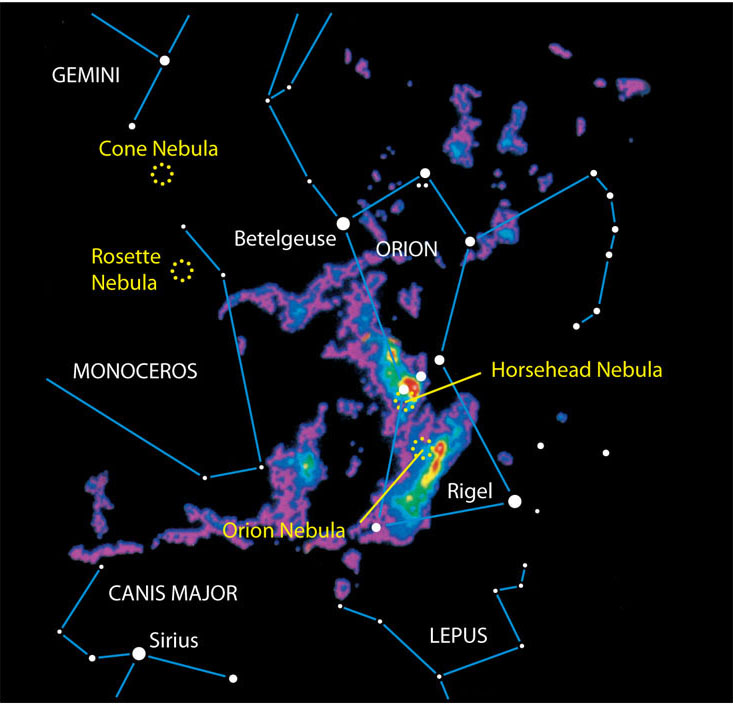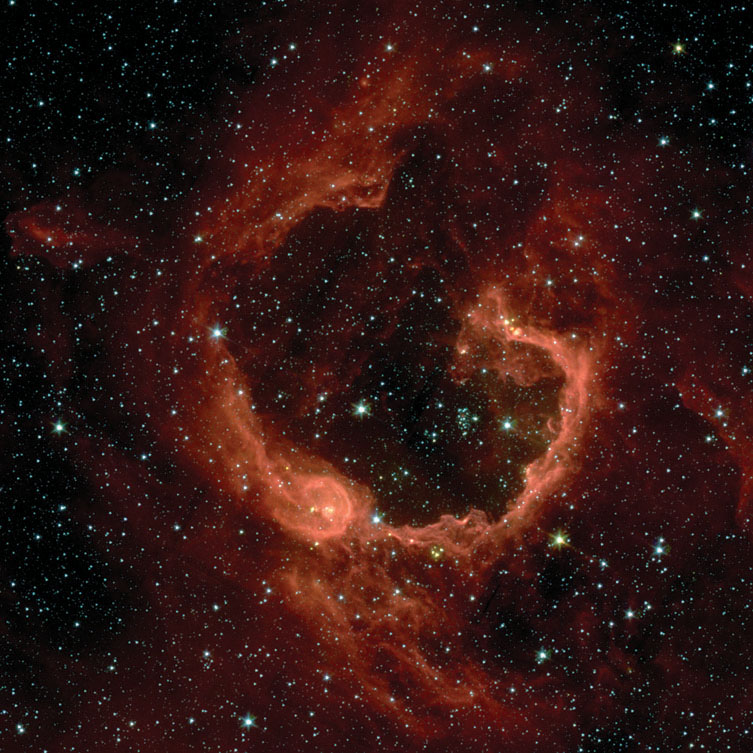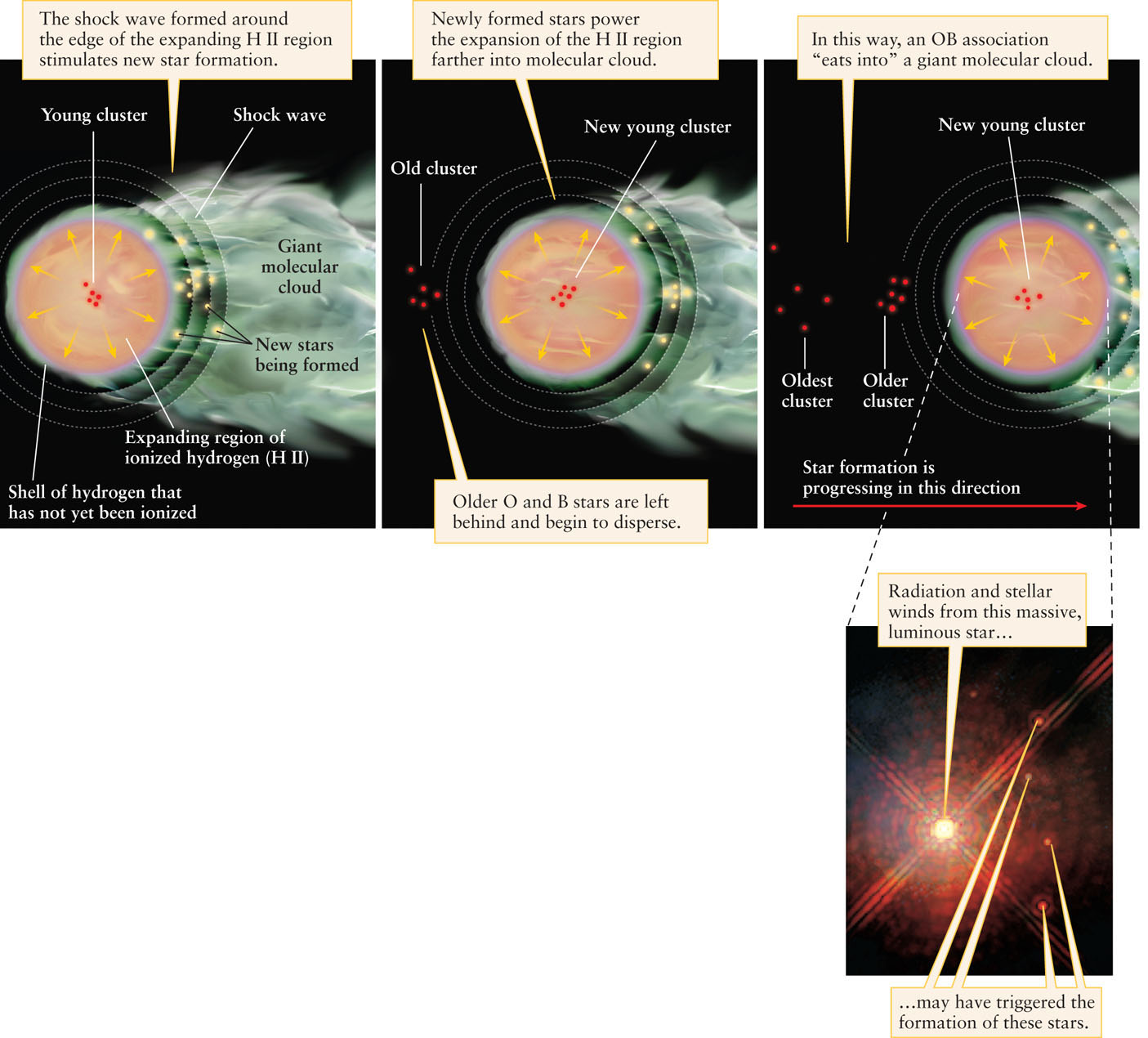18-7 Star birth can begin in giant molecular clouds
We have seen that star formation takes place within dark nebulae. But where within our Galaxy are these dark nebulae found? Does star formation take place everywhere within the Milky Way, or only in certain special locations? The answers to such questions can enhance our understanding of star formation and of the nature of our home Galaxy.
Exploring the Interstellar Medium at Millimeter Wavelengths
Dark nebulae are a challenge to locate simply because they are dark—they do not emit visible light. Nearby dark nebulae can be seen silhouetted against background stars or reddish H II regions (see Figure 18-2), but sufficiently distant dark nebulae are impossible to see in contrast with background visible light because of interstellar extinction from dust grains. They can, however, be detected using longer-wavelength radiation that can pass unaffected through interstellar dust. In fact, dark nebulae actually emit radiation at millimeter wavelengths.
Observing the Galaxy at millimeter wavelengths reveals the cold gas that spawns new stars
Such emission takes place because in the cold depths of interstellar space, atoms combine to form molecules. The laws of quantum mechanics predict that just as electrons within atoms can occupy only certain specific energy levels (see Section 5-8), molecules can vibrate and rotate only at certain specific rates. When a molecule goes from one vibrational state or rotational state to another, it either emits or absorbs a photon. (In the same way, an atom emits or absorbs a photon as an electron jumps from one energy level to another.) Most molecules are strong emitters of radiation with wavelengths of around 1 to 10 millimeters (mm). Consequently, observations with radio telescopes tuned to millimeter wavelengths make it possible to detect interstellar molecules of different types. More than 100 different kinds of molecules have so far been discovered in interstellar space, and the list is constantly growing.
Hydrogen is by far the most abundant element in the universe. Unfortunately, in cold nebulae much of it is in a molecular form (H2) that is difficult to detect. The reason is that the hydrogen molecule is symmetric, with two atoms of equal mass joined together, and such molecules do not emit many photons at radio frequencies. In contrast, asymmetric molecules that consist of two atoms of unequal mass joined together, such as carbon monoxide (CO), are easily detectable at radio frequencies. When a carbon monoxide molecule makes a transition from one rate of rotation to another, it emits a photon at a wavelength of 2.6 mm or shorter.
The ratio of carbon monoxide to hydrogen in interstellar space is reasonably constant: For every CO molecule, there are about 10,000 H2 molecules. As a result, carbon monoxide is an excellent “tracer” for molecular hydrogen gas. Wherever astronomers detect strong emission from CO, they know molecular hydrogen gas must be abundant.
Giant Molecular Clouds
The first systematic surveys of our Galaxy looking for 2.6-mm CO radiation were undertaken in 1974 by the American astronomers Philip Solomon and Nicholas Scoville. In mapping the locations of CO emission, they discovered huge clouds, now called giant molecular clouds, that must contain enormous amounts of hydrogen. These clouds have masses in the range of 105 to 2 ×106 solar masses and diameters that range from about 15 to 100 pc (50 to 300 ly). Inside one of these clouds, there are about 200 hydrogen molecules per cubic centimeter. This density is several thousand times greater than the average density of matter in the disk of our Galaxy, yet only 10–17 as dense as the air we breathe. Astronomers now estimate that our Galaxy contains about 5000 of these enormous clouds.
Figure 18-22 is a map of radio emissions from carbon monoxide in the constellations Orion and Monoceros. Note the extensive areas of the sky covered by giant molecular clouds. This part of the sky is of particular interest because it includes several star-forming regions. By comparing the radio map with the star chart overlay, you can see that the areas where CO emission is strongest, and, thus, where giant molecular clouds are densest, are sites of star formation. Therefore, giant molecular clouds are associated with the formation of stars. Particularly dense regions within these clouds form dark nebulae, and within these stars are born.


Mapping Molecular Clouds A radio telescope was tuned to a wavelength of 2.6 mm to detect emissions from carbon monoxide (CO) molecules in the constellations Orion and Monoceros. The result was this false-color map, which shows a 35° × 40° section of the sky. The Orion and Horsehead star-forming nebulae are located at sites of intense CO emission (shown in red and yellow), indicating the presence of a particularly dense molecular cloud at these sites of star formation. The molecular cloud is much thinner at the positions of the Cone and Rosette nebulae, where star formation is less intense.
By using CO emissions to map out giant molecular clouds, astronomers can find the locations in our Galaxy where star formation occurs. These investigations reveal that molecular clouds clearly outline our Galaxy’s spiral arms, as Figure 18-23 shows. These clouds lie roughly 1000 pc (3000 ly) apart and are strung along the spiral arms like beads on a string. This arrangement resembles the spacing of H II regions along the arms of other spiral galaxies, such as the galaxy shown in Figure 18-8a. The presence of both molecular clouds and H II regions shows that spiral arms are sites of ongoing star formation.
Star Formation in Spiral Arms

A Star-Forming Bubble Radiation and winds from the hot, young O and B stars at the center of this Spitzer Space Telescope image have carved out a bubble about 20 pc (70 ly) in diameter in the surrounding gas and dust. The material around the surface of the bubble has been compressed and heated, making the dust glow at the infrared wavelengths used to record this image. The compressed material is so dense that new stars have formed within that material. This glowing cloud, called RCW 79, lies about 5300 pc (17,200 ly) from Earth in the constellation Centaurus.
In Chapter 23 we will learn that spiral arms are locations where matter “piles up” temporarily as it orbits the center of the Galaxy. You can think of matter in a spiral arm as analogous to a freeway traffic jam. Just as cars are squeezed close together when they enter a traffic jam, a giant molecular cloud is compressed when it passes through a spiral arm. When this happens, vigorous star formation begins in the cloud’s densest regions.
As soon as massive O and B stars form, they emit ultraviolet light that ionizes the surrounding hydrogen, and an H II region is born. An H II region is thus a small, bright “hot spot” in a giant molecular cloud (but keep in mind that light from an H II region comes from emission lines, and not blackbody radiation from hot matter). An example is the Orion Nebula, shown in Figure 18-1b. Four hot, luminous O and B stars at the heart of the nebula produce the ionizing radiation that makes the surrounding gases glow. The Orion Nebula is embedded on the edge of a giant molecular cloud whose mass is estimated at 500,000 M⊙. The H II regions in Figure 18-2 are located at a different point on the edge of the same molecular cloud, some 25 pc (80 ly) from the Orion Nebula.
Once star formation has begun and an H II region has formed, the massive O and B stars at the core of the H II region induce star formation in the rest of the giant molecular cloud. Ultraviolet radiation and vigorous stellar winds from the O and B stars carve out a cavity in the cloud, and the reddish H II region, powered by the stars, expands into it. These winds travel faster than the speed of sound in the gas—that is, they are supersonic. Just as an airplane creates a shock wave (a sonic boom) if it flies faster than sound waves in our atmosphere, a shock wave forms where the expanding H II region pushes at supersonic speed into the rest of the giant molecular cloud. This shock wave compresses the gas through which it passes, stimulating more star birth (Figure 18-24).
Newborn O and B stars further expand the H II region into the giant molecular cloud. Meanwhile, the older O and B stars, which were left behind, begin to disperse (Figure 18-25). In this way, an OB association “eats into” a giant molecular cloud, leaving stars in its wake.

How O and B Stars Trigger Star Formation Stellar winds and ultraviolet radiation from young O and B stars produce a shock wave that compresses gas farther into the giant molecular cloud. This stimulates star formation, producing more O and B stars, which stimulate still more star formation, and so on. Meanwhile, older stars are left behind. This figure only illustrates new star formation in the rightward direction, but it could be spherical in a real cloud. The inset shows a massive star that has spawned other, smaller stars in this way. These stars are about 770 pc (2500 ly) from Earth in the Cone Nebula, a star-forming region in the constellation Monoceros. The younger stars are just 0.04 to 0.08 ly (2500 to 5000 AU) from the central star.
CONCEPT CHECK 18-8
How can O and B stars initiate star formation in a giant molecular cloud?
Ultraviolet light from hot O and B stars creates an H II region that expands into the surrounding molecular cloud. This compresses the cloud, causing star formation.